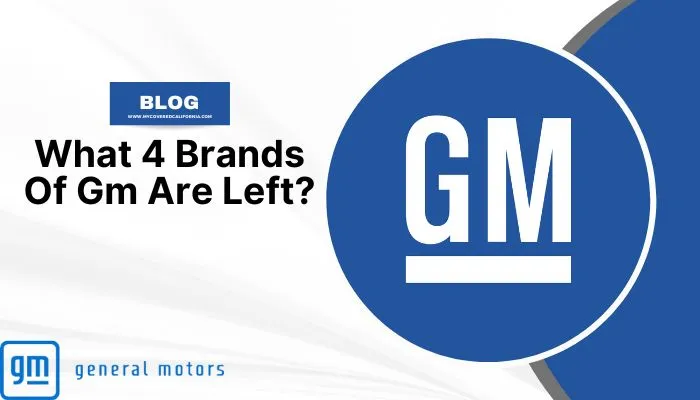What 4 Brands Of GM Are Left? GM as known is a popular car manufacturing company whose car models are many and diverse. It was founded in the year 1908, and since then, it has played a significant role in shaping the global automotive industry.
GM has evolved significantly over time due to changes in market tastes and preferences. In the process, some brands were merged while others were discontinued and only a few remained with improved capabilities.
This article therefore offers an extant comprehensive review of General Motors’ brand portfolio focusing on the four that have been around for a long.
This paper now will take us through the journey to reveal these remaining four GM brands; which factors make them exist up to this day?

What 4 Brands Of GM Are Left?
From the time General Motors Company was founded by William C. Durant, it became one of those companies whose historical trajectory is marked more with innovations than challenges until today.
Thus, from being nothing but a holding company to becoming a globally recognized automobile manufacturer giant, General Motors has demonstrated how adaptable it can be.
The evolution in GM’s brand portfolio mirrors changes in type of vehicles demanded by customers over time in light of changing automotive market trends due to innovation or competitive influence among others things like iconic appearances or the market situation at any given point in time.
Brand Consolidations and Discontinuations
Market dynamics coupled with economic considerations have pushed GM into various strategic brand consolidations aimed at ensuring efficiency as well as model discontinuation.
Understanding these decisions gives us an idea about why this company strives to maintain its competitiveness.
The Four Remaining GM Brands
During the brand consolidation exercise, four brands remained which have each retained their distinct identities and contributed to General Motors’ success.
These are the main focus of this study; they include Chevrolet, GMC, Buick, and Cadillac.
Chevrolet
Let’s look into Chevrolet in detail:
| Aspect of Chevrolet | Details |
|---|---|
| History within GM | Chevrolet, also known as Chevy, has been a part of General Motors (GM) since 1911. It is recognized as one of the most reliable car manufacturers, known for producing great model cars. |
| Current Lineup | Chevrolet’s lineup includes a variety of car types such as sedans, SUVs, trucks, and electric vehicles. Notable models include the Silverado, Equinox, and Corvette, catering to diverse customer needs. |
| Brand Strengths | Chevrolet stands out for its combination of innovation and affordability. It integrates modern technologies, safety features, and performance capabilities while remaining accessible to many customers. |
| Recent Innovations | Chevrolet continues to lead in innovation, with advancements in electric vehicle technology and the integration of smart features. The brand dynamically adapts to the evolving needs of the automotive industry. |
GMC
Let’s look into GMC in detail:
| Aspect of GMC | Details |
|---|---|
| GM Brand Identity | GMC, established in 1911, focuses on trucks and utility vehicles within the General Motors (GM) family, carving out a niche in the automotive market. |
| Historical Perspective | Known for the development of strong and durable trucks, GMC has built a reputation for quality, performance, and professional-grade vehicles, earning trust for dependability. |
| Current Lineup | The current GMC lineup includes a range of trucks and SUVs, featuring models like Sierra, Canyon, Yukon, and Acadia, all exemplifying GMC’s commitment to competency, style, and advanced technology. |
| USPs & Market Positioning | GMC positions itself as a brand for those seeking functional yet stylish vehicles, distinguished by advanced design features and high-tech components. |
Buick
Certainly! Here’s the requested information about Buick formatted as a table:
| Aspect of Buick | Details |
|---|---|
| Historical Context | Buick, a GM brand since the early 20th century, epitomizes luxury and sophistication, with a history of dedication to craftsmanship and innovation. |
| Present Vehicle Range | Buick’s current lineup, including models like Enclave, Encore, and Regal, blends modernity with classic elegance, emphasizing a premium driving experience with comfort and advanced features. |
| Market Demographics & Positioning | Targeting upscale consumers, Buick offers luxury without compromising on practicality, featuring lavish interiors and modern safety systems for smooth rides. |
| Recent Developments & Innovations | Buick stays innovative with features like advanced driver assistance systems (ADAS), connectivity options, and fuel-efficient powertrains, maintaining its relevance in the competitive market. |
Cadillac
Now that Chevrolet, GMC, and Buick have been extensively covered regarding their detailed histories and current state of affairs, we can shift gears into discussing Cadillac and its luxury segment.
| Section | Description |
|---|---|
| Cadillac’s History | Established in 1902, Cadillac, named after French explorer Antoine Laumet de La Mothe Sieur de Cadillac, quickly became known for luxury and innovation, reflecting the evolution of automobile technology and design. |
| Current Lineup | Cadillac’s diverse lineup includes sporty CT4 and CT5 sedans, and luxurious XT4, XT5, and Escalade SUVs, catering to a wide consumer base with a blend of advanced technology, opulent interiors, and robust performance. |
| Brand Image & Positioning | Cadillac has cultivated an image of elegance and luxury, symbolizing a sophisticated lifestyle and success, appealing to discerning customers seeking more than transportation but a symbol of wealth. |
| Innovations & Technology | Committed to innovation, Cadillac integrates technologies like the Super Cruise semi-autonomous driving system and modern infotainment systems, reinforcing its status as a leader in luxury automotive. |
Check back for more on how Cadillac remains the epitome of class in the world’s automobile industry.
Comparison of the Remaining GM Brands
Each one caters for a specific market segment with varied offerings such within the GM portfolio is quite diverse.
And while Chevrolet is all about value for money and versatility, GMC aims at targeting those who prefer tougher vehicles like trucks and SUVs that can do more work rather than simply driving around on roads or highways.
Buick aims to strike a balance between luxuriousness and accessibility given that it falls under Cadillac’s aspiration towards being premium.
Key Differentiators and Strengths of Each Brand
Chevrolet: Recognized for reliability and affordability; strengths include broad appeal across various models.
- GMC: Known for having rugged lineup basing on a truck-based SUV foundation.
- Buick: Provides features that are premium quality while still affordable by many consumers.
- Cadillac: Its strengths lie in extravagant designs, cutting edge technological advancements as well as prestigious brand identity.
Market Positioning and Target Demographics
Its wide range of clients include families, commuters and budget-minded individuals. This brand is popular among consumers with a preference for outdoor activities and work-related tasks while also seeking for trucks that are robust and reliable.
Besides being affordable to many, this company targets matured people who want some luxury in their purchase.
The cars are intended for the rich who value leisure, performance and an image that suggests they associate with premium brands.
Challenges Faced by GM Brands
The automotive industry faces various challenges from outside including:
| Global Economic Uncertainty: Changes in economic conditions affect buying power of customers. |
| Regulatory Changes: As emission standards as well as safety regulations change, auto companies have to adapt quickly. |
| Supply Chain Disruptions: Events worldwide have led to disruptions in supply chains which eventually affects production processes and product delivery too. |
Internal Challenges Faced by General Motors and its Brands
Technological Adaptation: Rapid advancements in electric motors and autonomous driving require keeping up with the pace of technological progress hereof.
- Brand Perception: Need to ensure consistent positive perception across various markets Observe consistent perception as well as favorable view all over diverse markets [brand identity management].
In order to overcome these challenges, General Motors has taken several strategic initiatives like:
- Investment in Innovation: Allocating resources for research and development so as to be at the forefront of automotive technology (GM website).
- Global Market Analysis: Adapting products and strategies based on regional market trends (GM website).
Incorporating sustainability into production processes as well as vehicle design (GM website).
Future Outlook for GM Brands
More emphasis on eco-friendly technology as well as self-driving cars. Integration of high-tech connectivity features to ensure smoother driving experience. Continuous search for futuristic and streamlined shapes.
An increasing demand by customers for vehicles which are environment-friendly. More reliance on sales, service and connectedness over digital platforms. The rise in shared mobility solutions affecting traditional ownership models.
Potential Expansions or Changes to GM’s Brand Lineup
Some of the possibilities are:
| Category | Description |
|---|---|
| Expansion into New Segments | Exploration of new markets and vehicle categories. |
| Strategic Alliances | Partnering with technology companies or other automakers to enhance capabilities. |
| Portfolio Optimization | Realigning brand portfolios to match shifting consumer preferences. |
| Challenges for GM Brands | |
| Rapid Technological Shifts | Adapting quickly to changes in the technology landscape. |
| Global Economic Factors | Responding to economic fluctuations that affect consumer spending and market demand. |
| Regulatory Changes | Navigating and adhering to evolving global regulations. |
Conclusion
In summary, “What 4 Brands Of GM Are Left?” this extensive review of General Motors’ brand portfolio examines Cadillac’s rich history and present status, gives comparative analysis of other brands remaining, talks about existing problems, and imagines what may happen next in this respect.
GM’s brand portfolio has an enduring importance within the automotive industry, covering a wide array of offerings that cater to diverse customer preferences. By being innovative, luxurious and adaptive, General Motors positions itself as one the main players within a constantly developing automotive industry.
To be in touch with the market trends, technological breakthroughs and strategic steps by GM as an automaker enthusiast, consumer or a professional person within the industry it is very necessary as automotive sector changes with time.

Hello there, I’m Loretta Flores, your go-to Customer Support Specialist for the GM-Socrates platform. Leveraging my 3 years of experience, I am here to work together to streamline your processes and maximize efficiency.